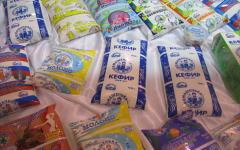It is known that tactile sensations (that is, touch, sensations of touch) directly affect the development of the human nervous system, in particular the brain. Drawing is a huge experience in terms of color perception, subtle tactile sensations and a real pleasure, it's incomparable! Most of us never draw, and we impoverish ourselves by doing so. In this article, we will talk about finger paints for the little ones and about how to teach a kid to draw.
There is a myth that a baby at the age of 6-7 months - "non-smart" - this word roams the parent magazines, reflecting the widespread opinion. Or here's another fact: many (even very good) fathers believe that a child under one year old is a "piece of pink flesh" and communication with him is impossible.
And it's not like that: children at this age, if you actively and correctly develop them, are completely contact and quite conscious people.
How to develop a child and his creative abilities? It is useless to give a child a brush in the hands of up to three years old: it is generally useless to do this for 3 years, because the muscles of the hands are not yet well developed so that the child can consciously adjust the length of the lines and draw figures of a certain shape.
What to do? There is a way out - give the child finger paints and you give him the opportunity to express himself.
Let him not draw specific objects, he will transfer his feelings to paper, for example, instead of his mother, he will draw his love for her, instead of the sea, he will depict feelings of lightness and weightlessness.
At what age can you draw with your fingers? Already a 5-month-old baby can already be offered finger paints and a large sheet of paper (the more the better). At first, you can give only 1 jar of paint - for example, yellow. Then enter the rest of the colors. With a break of several days (or months), show the baby how to draw with fingers, palms, how to mix paints.
The game promotes color perception, development of attention, hand movements, social adaptation. With the help of self-drawing, music, dancing, the child learns to remove negative emotions, unspoken grievances, inexplicable anxieties and fears.
In addition, finger paints develop fine motor skills well, which affects not only the baby's ability to use their pens, but also contributes to the development of speech. How? The fact is that the center responsible for movement is located in the cerebral cortex very close to the speech center, and when the first one starts working, it makes the second one work as well.
With these paints you can draw not only on paper, but also on cardboard, glass, even on the body. And also - which is a big plus for moms - they are well washed off from any surface and are easy to wash. And most importantly, they don't taste good!
note to the fact that you can draw with finger paints with a baby when he splashes in the bathroom - you can wash off the paint from the walls and from the child in a few minutes.
How to start drawing?
Put the baby on your knees, show him how to draw. Dip your finger into the paint and make a few strokes. Do this for a minute at least every day, and let this stage take a month. At some point, smear his own finger or palm with paint and run his hand across the paper. Make it so that the child is actively watching! Passed his hand over the paper, wiped his fingers - a half-minute drawing session was over. And let such classes - with minimal forward movement - take one and a half to two months, and no less. Don't rush anywhere! You must convey to the child a mysterious principle: you can transfer paint from your hand to a white sheet!
Finger paints (from 3 months to 6 months):
Finger paints (from 6 months to 12 months):
Finger paints (from 1 year to 1.5 years):
Finger paints (from 1.5 years to 2 years):
Finger paints (after 2 years):
Finger paint recipes: How to make your own finger paints.
Finger paint recipe #1. 0.5 kg flour, 5 tbsp salt, 2 tbsp vegetable oil, add water - until the consistency of thick sour cream.
Mix all this with a mixer, then pour the resulting mass into separate jars, add food coloring (beetroot or carrot juice, as an option - Easter sets), mix until smooth.
Finger paint recipe #2. In a bowl, mix 1/3 cup cornstarch and 2 tablespoons sugar. Add 2 cups of cold water and put on a small fire. Cook for 5 minutes, stirring constantly, until the mixture becomes a translucent gel-like mass. When this mass has cooled, add 1/4 cup of liquid dishwashing detergent to it (this will make the paints easily washed off clothes and other surfaces.) Then the mass should be divided into several portions and either food coloring or non-toxic gouache should be added to each portion.
Finger paint recipe #3. Mix 1.5 cups of starch and 0.5 cups of cold water until smooth. Add a liter of boiling water there, stirring continuously until a transparent mass is obtained. Continuing to stir, add 0.5 cups of talc. When the mixture has cooled, add 1.5 cups of soap chips and stir well. Pour into jars, tint with powder tempera and cool slightly.
So, Drawing with finger paints contributes to the early development of creative abilities. Not because the kid is learning to draw, but because he is learning to express himself, to convey his feelings and impressions.
And, finally, by arranging a drawing session for your little one, you will simply give him and yourself great pleasure! After all, small children love new games so much, something unusual, and if they suddenly allow them to “soil” their hands and everything around, a storm of delight is guaranteed!
The secrets of making amazing things, gifts and cards with your own hands -
Finger games for kids in easy and affordable tips.
The benefits of drawing for children
You can draw even from 6 months of age, you just need to choose the right colors. Children really like this activity and bring great pleasure, because it is by drawing that they give freedom to their imagination, get rid of negative emotions, develop, learn something new, expand existing boundaries and form their worldview.
Finger paints for kids
For the little ones, finger paints are well suited.
- You can give them to a baby from about six months of age.
- Such paints are specially made for the smallest and they do not contain harmful and toxic ingredients, they are made using food coloring, because small children put everything in their mouths and taste it.
- To prevent children from doing this, salt or another ingredient is usually added to the paints, after tasting which the child will no longer want to repeat it.
- Finger paints are easily washed off from any surfaces, washed off from the skin of a child, washed off from clothes


Child development by drawing
The benefits for children from such creativity are enormous: fine motor skills develop, which in turn affects the speech and memory of the baby. When drawing with finger paints, the child's nervous system also develops, he learns to sit and walk correctly.
Drawing with fingers, children perceive colors better, see the boundaries of their work. In the process of creativity, you can study colors, shapes, counting, paint animals and various objects that you will introduce your baby to.


Organization of the process of drawing with finger paints
The drawing process itself is very exciting, so do not forget about the precautions:
- dress your child in clothes you don't mind getting dirty
- put on a bib or apron, there are special aprons for creative work
- use a large sheet of paper, preferably whatman paper or a piece of wallpaper, so as not to limit the child
- if you draw on the floor, lay an oilcloth under the bottom
- transfer part of the paint with which you will draw to other containers so that the child does not use all the paint at once, and he will do just that if you give him the whole jar; can be transferred to lids or toy dishes
- prepare wet wipes or a wet cloth


It is better to start drawing when the child is in a good mood, so that drawing is associated only with positive emotions.
How to teach a child to draw with finger paints?
So, you have decided to introduce your child to finger paints. For the first acquaintance you need to know:
- the child must be well-rested, not hungry, in a good mood
- do not give the child several colors at once, limit yourself to one at first so that the child does not get confused
- the first lesson can last 2-3 minutes, this is normal, let the child get used to the new material
- if the child has lost interest in work, has begun to scatter jars of paint, it's time to finish today
- at first, the child most likely will not draw, this is natural, he needs to master and understand something new; he will most likely dip his pens into the paint and will examine it on his pens, squeeze them, happen as the paint smacks, feel the material that is new to him


How to draw with finger paints? Photo
Dip the child's finger in the paint and put a dot on the piece of paper, then draw a line. You can use cotton swabs and make dots with them. Let the child try to dip a piece of sponge and draw with it. Let him dip his palm and leave its imprint on paper. In general, turn on your imagination and create.






It is very interesting and unusual to spend time with finger paints in the bathroom. You can either just draw on the bathroom or tile, or you can stick whatman paper or wallpaper on the wall above the bathroom and draw on them.
The field of activity for the child is large, but it will not be difficult to wash it all, and most importantly, the child will not be able to go beyond the boundaries of the bath and dirty the whole house. You will see, the child will really like this activity!




For older children, you can color in the pictures or print some images yourself, such as mushrooms or leaves, so that they are large and with little detail. Decorate them with your fingers or a cotton swab, it is convenient to decorate large pictures with a sponge. 



Or make a stencil - cut something not complicated on cardboard with a clerical knife, attach it to our Whatman paper and apply paint over the stencil with a sponge, and then remove it, you get an interesting picture. Show it to your child first, and then let him try it himself. 

There are also many other interesting ways to paint with finger paints. Here are some examples of how to draw an animal, butterfly or other objects with fingers and palms. There is nothing complicated here, but what a result!










It is important in this lesson to show the child how to draw and give complete freedom. Do not say what he is doing wrong, just show him everything, and then he himself will figure out how to draw and where. Be sure to praise him - for him it is very important.




How to choose paint for drawing and how to work with it: tips
- Before buying, check the composition of the paint, it is advisable to ask for quality certificates, because. paint should be safe for your baby. The composition should not contain any harmful substances, only food dyes should be used, because children often taste the paint
- Choose colors according to the age of the child, see what is written on the package. Some manufacturers offer such paints from 1 year, some from 2 or 3 years.
- You should not buy a kit with a bunch of all kinds of colors, at this age the child needs to learn only the basic ones: red, blue, yellow and green. As a rule, paints are just sold in jars of 4 or 6 colors, you don’t need more.
- It would be nice if you painted with the color that you are currently learning. It will help the child to easily, in the game, learn colors
- For drawing, choose whatman paper or a piece of wallpaper, because an A4 sheet is not enough for a small child, he still does not know how to see the boundaries and not go beyond them, so he will decorate everything around you
- Take care of how you will clean everything up later, because having got used to it, the child can forget about whatman paper and explore the territory beyond it, draw on himself or you. It is best to cover everything with oilcloth and dress in old clothes.


How to make finger paints at home yourself: a recipe
There are several recipes for finger paints, let's look at one of them, in our opinion the most suitable.
Take:
- 2 tbsp. white flour
- 7 art. l. fine salt
- 1.5 st. plain water
- 1.5 st. l. any vegetable oil, preferably refined (odorless)
- food coloring of desired color


Mix flour with salt, slowly pour in water and mix, otherwise lumps will form that we don’t need at all, you can even beat with a blender or mixer. Then put in the oil. The consistency should resemble liquid sour cream, adjust the density with flour and water. Now you can divide the mixture into jars and add food coloring in different colors.
That's all, the colors are ready. Let your kid draw with them only for fun!
How to order finger paints in the Aliexpress online store?
Video: Drawing with finger paints! There is no limit to the imagination of children! Full version
List of lessons:
How to draw with finger paints? What it is is not difficult to guess, the name speaks for itself. paints for drawing exactly fingers, not brushes.
Why fingers, and What is the difference from ordinary? Everything is very simple. These paints are designed for the smallest artists, our beloved little ones, who still do not know how to properly hold brushes in their hands and draw with them, due to the fact that the muscles of the hands under 3 years old in children are not sufficiently developed.
These paints do not need to be diluted with water, they have the consistency of thick sour cream, just dip your finger and paint. They don't run or drip. And most importantly, these paints are non-toxic and completely harmless to babies (at least that's what the manufacturers promise us).
At what age should you start drawing?
I heard about these “magic” paints a long time ago, but at what age you should start drawing with a child, I had no idea. When my daughter turned one year old, I decided to try to paint with my princess. To my great surprise, my daughter really liked the drawing process. True, she still doesn’t care where to draw, on paper, on a chair or on herself. I read several articles on the Internet and found out that you can draw with such paints from the age of six months, when the child begins to sit. However, my opinion on this matter is completely different.
Literally up to a year, my baby pulled almost everything into her mouth, it was useless to take it away if only hold hands all the time. Not I represent how can you draw with a child, if he strives to eat paints all the time, especially since they are so bright. Although, if I have another baby, I probably will try. If suddenly you offered your kid to draw, and he categorically refuses, do not be upset, try in a week or another. After a year, babies begin to develop especially quickly, which they did not want or could not do yesterday, today they already do it with pleasure. For example, I tried to explain to my daughter that you can draw with a felt-tip pen, but she didn’t want to do it in any way. A week went by and we tried again. Now my sun guides the paper with any writing object, and it gives her great pleasure.

Where to begin?
I also asked myself this question when I first bought finger paints. Start by simply putting the little one in the chair and open the can of paint, and then everything will go by itself. Dip your finger in the paint and draw something. The baby will like it and he will want to try it himself. If the child is inactive, help him. Take the baby by the hand, dip his finger in a jar of paint and swipe across a sheet of paper. Let this be your first drawing lesson over, do not rush. And the second and third classes can be similar to the first, everything will come with time. At first, my daughter really liked just putting her index and thumb fingers into the jar and rubbing the paint with them. Did she study them by touch? And then I began to “draw” little by little.
What are the benefits of finger paints?
Very big. Drawing such paints develops fine motor skills. Gives an idea to the child about the color (drawing with the baby, pronounce the colors). Teaches the child to build cause-and-effect relationships, develops thinking. What else? Yes, it just charges the little one with positive energy.
Finger paints are a real find for parents who care about the correct and timely development of their child. Finger paints appeared on our market relatively recently, but they have already managed to win the love of many moms and dads.
The main benefit of finger paints is that they contribute to the development of fine motor skills and imagination. Of course, a child can also draw with felt-tip pens, pencils or brushes, but this happens much later, since the child needs to learn how to use these objects and hold them in his hands. You can use finger paints almost from the first months, and for children such an activity will be more fun and interesting.
Benefit
The benefits of using this type of paint are invaluable. The benefits of finger paints include:
- the development of fine motor skills (helps prepare the baby's hand for drawing with felt-tip pens, pencils or other objects for drawing);
- development of tactile sensitivity;
- development of creative thinking and imagination;
- the ability to teach a child to distinguish colors during the game;
- development of perseverance and concentration, the child becomes calmer;
- safety - finger paints are made from safe components, so do not be afraid that the paint will enter the child's body.
All of the above arguments are quite convincing; for many mothers, only the safety of finger paints may remain in question. If you have doubts about the quality of finger paints, or you do not trust manufacturers, it is quite possible to prepare paints yourself.
Recipes
To prepare finger paints for a child's creativity, you will need the following ingredients:
- half a kilogram of flour;
- five to six tablespoons of salt;
- two to three tablespoons of vegetable oil;
- two tablespoons of water.
All components must be mixed in a container, and then using a mixer, knead the mixture until the consistency of thick sour cream is obtained. The resulting mass must be poured into jars, and then can be dyed with food coloring - carrot or beetroot juice. Alternatively, you can also use dyes from Easter kits. After mixing in the dye, mix the mixture again until a homogeneous mass is obtained.
For another recipe, you will need the following ingredients:
- a third of a cup of starch;
- two tablespoons of sugar;
- two glasses of cold water;
- a quarter cup of liquid baby dishwashing detergent.
Mix starch, sugar and water in a saucepan, put on fire. Cook over low heat, stirring constantly, for about five minutes, until the mixture becomes clear and has a gel-like consistency. When the resulting mass has cooled, you need to add a quarter cup of liquid baby dishwashing detergent to it (this will make it easier to wash the paint from various surfaces and wash it from clothes). The resulting mass can be divided into portions, and then add food coloring to each portion.
And another recipe for finger paints, for which you will need:
- one and a half glasses of starch;
- half a glass of cold water;
- a liter of boiling water;
- half a glass of talc;
- one and a half cups of soap shavings.
Mix one and a half cups of starch with a half cup of cold water until smooth. Add a liter of boiling water to the resulting mass, stir continuously. You should get a clear mixture. Without ceasing to stir, pour half a glass of talcum powder, cool the mixture. When it cools down, add one and a half cups of soap chips to it and stir well. Pour the resulting mass into jars and add dye (powder tempera).
Having made finger paints yourself according to one of the above recipes, you can be sure of their high quality and absolute harmlessness of paints for your child.
When to use
Many parents are wondering at what age it is better to start using finger paints. There is no definite answer to this question, some parents begin to give paints to children from a few months, while others wait until the child is at least one and a half to two years old.
However, there is an opinion that the optimal age for getting to know finger paints is 8 months (for each child, the optimal time is individual). However, no matter what age you start, you need to remember that the methods of drawing with paints for very young children and older children will be different.
If your baby is between eight months and a year old, let him paint with your help, show him an example. To master the technique, you will only need a large sheet of white paper and the finger paints themselves. To diversify your creativity, you can prepare stencils. It is clear that a one-year-old child will not be able to draw a Christmas tree or a butterfly, but you can attach a stencil with carved outlines of the same Christmas tree to his "arts".
A child from a year old will be happy with creativity in the bathroom. And parents will like this idea too. After all, it is much easier to wash a tile from paint than, for example, wallpaper. Therefore, the child will not be limited in space and surfaces used. You can draw with paints not only with your fingers, but also with a sponge, which leaves fairly even prints, which your child will undoubtedly like.
For older children, there are special coloring pages designed specifically for using finger paints. Your kid will be able to color his favorite characters from cartoons and books, alternating colors and mixing colors at his discretion.
Preparing for creativity
To make the process of drawing with finger paints as interesting as possible for your child and not too burdensome for you, you need to properly prepare.
What should be done:
- dress your baby in clothes that you don’t mind getting dirty;
- cover the workplace (floor or table) with a large piece of wallpaper or paper;
- lay a film on the floor or under the table;
- in the event that the paint jars are small or slippery, transfer some of the paint to saucers;
- you should always have handkerchiefs or wet wipes at hand;
- Be sure to have your camera or camcorder ready to capture your creative moments.
On most finger paints it is written that the recommended age for their use is from two years old, on the rest - from three. But it seems to me that with kids it is possible and it is necessary to be engaged earlier. We started to paint with fingers at 10 months, and I think it's not too early. If drawing is a pleasure for a child and his parents, then why not start drawing when you want?
What to look for when choosing finger paints
Finger paint- The paint must be as safe as possible for the child . Do not contain harmful substances, be environmentally friendly, so that even if the baby gets into the mouth, nothing terrible will happen (I mean, if the child licks his finger, and does not eat a jar of paint 🙂). So before buying it would not be superfluous to check the availability of paint quality certificates;
- Don't buy too many colors . Often, four colors are sold in packages, for the first time they will be enough with the head. Do not overload the child with unnecessary information and the desire to try everything at once;
- It is very good to draw with those colors, which you are currently studying with your child . For example, we draw with them. We have fun and at the same time consolidate the material covered. You can even dedicate a whole day to a particular color. Look for toys of this color with the baby, ask him to bring colored cubes, dishes, decor elements. Of course, we will also draw with this color;
- best to draw on paper . A4 album sheets may turn out to be too small for your baby's creativity to fly, therefore, stock up on “canvases” for your artist in advance so that nothing can interfere with your joint creativity;
- Be prepared for the fact that when the child gets into the taste of drawing, paint will be everywhere : on him, on you, on the floor or table, furniture and carpets, so it would be nice to take care of how to wash it all afterwards. For me, the best option turned out to be drawing on the floor. I cover the area given over to the artist’s workshop with oilcloth and don’t worry about cleaning afterwards 🙂
What is needed for creativity?
- Piece of drawing paper
- Finger paint
- Oilcloth cover the floor
- your good mood
Finger paints are very easy to make yourself. To clearly show you process of making finger paints(and also: do-it-yourself masses for modeling and colored cereals), I recorded a video 🙂
If you want to receive the video to your email, enter your coordinates in the form below - and I will try send you video as soon as possible, and - detailed step by step PDF instructions making all developing materials with your own hands.

I have deep respect for all my readers, so your data will never be shared with third parties and you will never receive spam, I guarantee.
So, enter the data in the form and get a video of the preparation of all educational materials today 🙂:
First lesson
The first lesson is very important and responsible. It depends on him whether your kid will like drawing, and in what atmosphere the classes will take place later. Therefore, the main rule is: start artistic work only in a good mood of the creator! The child should be disposed to creativity and to new discoveries.
So to start preparing a workplace (you need to think in advance where and how you will create, on what canvas, and in what clothes). We lay oilcloth, and on top of it whatman paper, change clothes, take out paints, prepare wet wipes and cheers - you can start creating!








